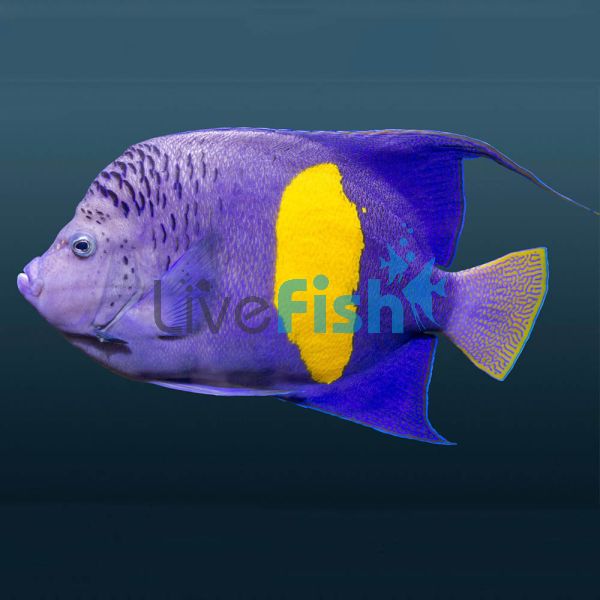Half Moon Angelfish - Medium Adult
The Half Moon Angelfish can shift the intensity of their colouring from darker to lighter. This is especially noticeable in the brilliance of the "map " blotch. When the "map" is turned "off," the fish appears two-toned, with a lighter purple-blue appearance in the front part of the body.
Half Moon Angelfish
The Half Moon Angelfish can shift the intensity of their colouring from darker to lighter. This is especially noticeable in the brilliance of the "map " blotch. When the "map" is turned "off," the fish appears two-toned, with a lighter purple-blue appearance in the front part of the body.
Adults can reach 19.7 inches (50 cm), but most people are under 13.8 inches (35 cm). This angelfish, like other Pomacanthus, can live for more than 20 years in the right conditions.
As a juvenile, their body is a deep blue, with a slight purple hue in some individuals. On the side, there are narrow vertical whitish to light blue thin bars alternating with thinner lines. Between the larger white curved bands, the lines are more delicate and thin. When the juvenile reaches 2.3" in length, a strong yellow band appears (6 cm). As the juvenile grows, its rounded dorsal and anal fins become more pointed, especially the tip of the dorsal fin.
The Half Moon or Maculosus Angelfish species lives primarily in coral and rocky areas at shallow to moderate depths. Though it prefers silty reefs over rich coral growth.
This species was first identified in the Red Sea and was later discovered along the northeast coasts of Africa and in the Arabian Gulf. This angelfish was also discovered near Japan, but it is more than likely that they were released into the wild by aquarists.
Tank Recommendations for Half Moon Angelfish
Once acclimated, this lovely angelfish is quite hardy and easy to care for. It can be a great first angelfish for a beginner or an excellent choice for an experienced aquarist. However, the keeper must have access to a very large aquarium to keep this Angelfish. A tank of at least 460 litres is required, with 757 litres being ideal. It will need regular water changes and there should be plenty of open space for swimming in the aquarium. They also need plenty of rock work with some large crevices for them to retreat into.
These fish will typically swim actively in open water, moving in and out of crevices. When it is well acclimated, it will venture to the surface in search of food. There are no specific requirements for water movement or lighting, though moderate lighting to promote natural algae growth is a good idea.
If properly cared for, it can live for 20 years or more.
Suitable Tank Buddies
This fish is not reef-safe because it picks at live corals, but it does well in a community tank with other larger and more aggressive species. It can also get along with other Pomacanthus Angelfish of varying colours and sizes. Yet, it can be aggressive towards larger angelfish, particularly angelfish of the same species. Because they are aggressive toward their own kind, it is best to keep only one per tank unless it is a known mated pair. Passive tank mates should be avoided as they will take a brutal beating from this angelfish, especially if it is a juvenile.
Usually Compatible
Hawkfish, Groupers, Eels, Damselfish and Tangs as well as aggressive smaller fish make good companions. Smaller non-aggressive species that are quick to retreat, such as Cardinalfish, Gobies, Butterflyfish Wrasses, and so on, can also be good candidates.
Sometime Compatible
These Angelfish can be kept in a community tank with aggressive and semi-aggressive fish. But need to make sure the other fish have places to hide if this angelfish decides to harass them. Filefish, Triggerfish, Batfish, and Boxfish are sometimes compatible.
Rarely Compatible
Do not keep Sharks, Rays, and Trunkfish with these Angelfish that may eat them. Also, slow-moving or sessile animals don't mix well because the Angelfish will pick at them and harm them out of curiosity.
Feeding your Half Moon Angelfish
The Half Moon Angelfish are omnivores. In the wild, they eat mostly sponges, tunicates, and algae. They will readily accept a wide variety of foods in the aquarium. Provide a varied diet that includes plenty of vegetables and sponge foods.
These fish will also accept frozen, pellet, and flake foods for angelfish that contain spirulina and sponge material. On occasion, meaty foods such as mysis shrimp and finely chopped fish or shrimp flesh can be given as a treat. Various blanched vegetables (you'll have to experiment with different items like spinach, broccoli, and so on to see which ones your fish prefers) and seaweed strips like Japanese Nori are also high in vitamins. Juveniles should be fed up to four times per day, while adults can only be fed twice per day.
| Scientific Name | Pomacanthus maculosus |
|---|---|
| Care Level | Easy |
| Common Names | Half Moon Angelfish, Map Angelfish, Yellow-Band Angelfish, Yellow-blotch Angelfish, Blue-moon Angelfish |
| Diet | Omnivore |
| Fish Family | Pomacanthidae Pomacanthus |
| Lifespan (years) | 20 |
| Max. Length (cm) | 50 |
| Min. Tank Volume (l) | 460 |
| Origin | Red Sea, northeast coasts of Africa, Arabian Gulf, Japan |
| Reef Safe | No |
| Sociability | Semi-aggressive |
| Venomous | No |
| Water Conditions | 26 to 29°C (79 to 84°F) |




